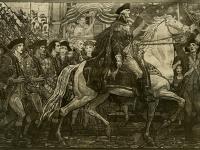Answer: Cogslea
In Philadelphia’s Mount Airy neighborhood (bordering on Chestnut Hill) stands a former barn that was once the studio of muralist and illustrator Violet Oakley. This was Oakley’s primary home for many years, and she shared the studio with her three artist friends—Henrietta Cozens, Elizabeth Shippen Green, and Jessie Willcox Smith. The studio was originally called “Cogs” and later “Cogslea,” from the initials of the artists’ last names.
Oakley was born into an artistic family in Bergen Heights, New Jersey, in June 1874. In the mid 1890s, she and her family moved to Philadelphia. At age 22, Oakley enrolled in the Pennsylvania Academy of the Fine Arts, but she developed more interest in illustration than fine art and transferred to the Drexel Institute (now Drexel University). There she studied under illustrator and author Howard Pyle. With Pyle's direction, Oakley created not only illustrations, but also murals and works in stained glass.
While her talent for illustration helped her win covers of popular magazines, it was her larger works that caught the attention of Joseph Huston, architect of the Pennsylvania state capital in Harrisburg. In 1902, he commissioned Oakley to create murals for the Governor's Reception Room. At the time, it was the largest public commission ever offered to a female artist. The 14-scene mural, titled The Founding of the State of Liberty Spiritual, depicted the story of William Penn and the establishment of Pennsylvania.
Cogslea (now called the Violet Oakley Studio) is listed on the National Register of Historic Places. Violet Oakley died in 1961, and she is buried at Green-Wood Cemetery, Brooklyn, New York.
HSP has several collections of related to Violet Oakley, including a collection of her sketchbooks (#3336), engraved plates for her work The Holy Experiment (#3334), and printed volumes pertaining to her works The Founding of the State of Liberty Spiritual and The Holy Experiment, and The Law Triumphant.

